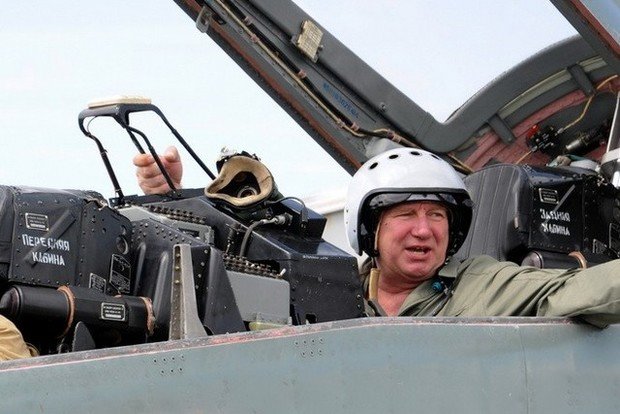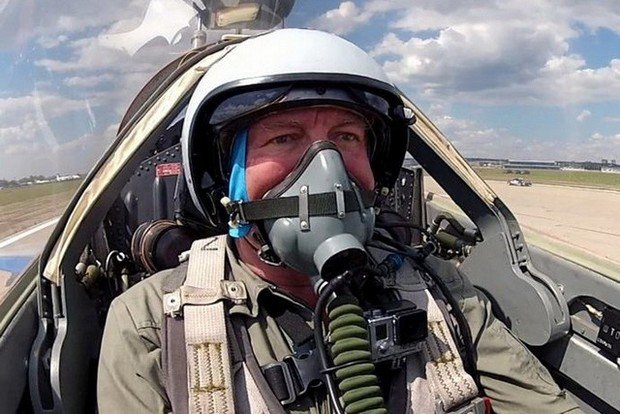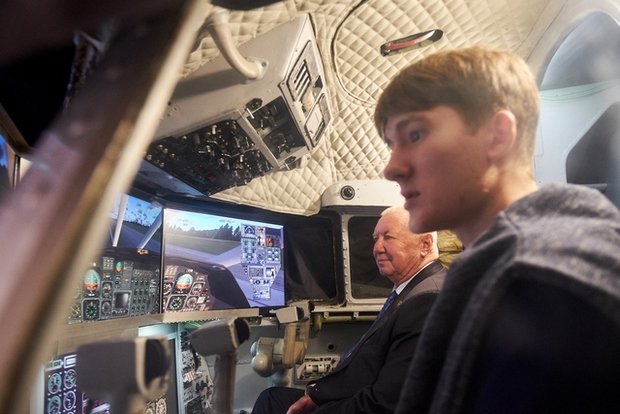''In Russia, aircrafts are tested by 73-year-old pilots. It's wrong''
Honoured Test Pilot of Russia tells about the system of training of test pilots
Only one school in Russia graduates test pilots. Training for this rare profession costs a lot of money, and it is possible to get into the ranks of students only through targeted recruitment from the airline or the design bureau. Kazan schoolchildren and students had an opportunity to learn about it first-hand: in early May, lessons of courage in two lyceums at KNRTU-KAI (Kazan National Research Technical University named after A.N.Tupolev) were held for them by three honoured workers of aviation. One of them is Hero of the Russian Federation, Head of the School of Test Pilots named after A.V. Fedotov, Alexander Krutov. Mr. Krutov told Realnoe Vremya about the first aircraft he tested, landing on the deck of the aircraft carrier Tbilisi and the system of test pilot training in Russia.
''Pilots aged 66 continue to fly and test aircrafts''
Why have you decided to tie your life to the sky?
At that time, I was living in the city of Ivanov, I was a 7th or 8th grade student. One summer I was walking in the yard, and the manager of the house approached us. She asked to tell our parents that for us it had been organized an excursion to the airport and everyone who wished could go there. When we arrived at the airport, we were put on An-2 and flown over the city. After this event, I wanted to see the land from above. I served ten years as a pilot in the army, then I wanted to achieve more in the profession and entered the school of test pilots.
How is the training of test pilots different from the training of military aviation pilots?
We have three types of aviation in the country: state, i.e. military, civil and experimental, which tests aircrafts for the first two types of aviation. A pilot cannot become a test pilot if he does not graduate our only school in the country. Pilots get into experimental aviation from civil or military one. It is impossible to train a person from the street, he must already be a pilot. When I entered the school of test pilots, I had to have 500 hours of flights on a fighter (now it is 200 hours). We do not teach how to fly, we teach how to test. I would not say that it is much more difficult, it's just a different kind of activity.
What are peculiarities of experimental aviation?
The pilot of civil aviation transports people, the pilot of military aviation shoots, blasts. We teach how to test the aircraft in modes that determine the capabilities of the aircraft. The test pilot determines the maximum and minimum speed of the aircraft. We test until it becomes clear that it is impossible to accelerate further, we determine the speed reserve at which nothing happens to the aircraft of military or civil aviation. Test pilots bring the aircraft to such an overload when it is almost falling apart.
We also test new devices. It is not dangerous, and it is basically the work of the test pilot. For example, we test the operation of engine. For example, the aircraft has three ordinary engines, and the fourth – experimental, it must be tested. Nothing will happen to the aircraft with three engines. It may happen that three is not enough, but it's not as scary as they tell. The most important thing is that the work of the test pilot is interesting and necessary. I am 66 years old, and I do not want to leave — I continue to fly and test aircrafts.
Is there an age limit in experimental aviation?
In civil aviation there is such a limit. For example, there can only be one pilot on board between the ages of 60 and 65. After 65 years, pilots are not allowed to fly abroad. For experimental aviation, the test pilot must have a good health to fly. The other day there landed an aircraft, which did not extend the nose landing gear. It was operated by a test pilot, who was 73 years old.
MiG-23 was the first tested aircraft
What was the first aircraft you tested in the Flight Research Institute named after M.M. Gromov?
MiG-23. Designers looked for methods to improve the aircraft. I was lucky to test it in interesting critical modes. Cylinders with compressed air were put under the aircraft and the compressed air was blown at large angles of attack over the wing: we studied how the aircraft would behave. It was my first job at the Flight Research Institute.
You tested the first Russian Yakovlev Yak-38 vertical take-off and landing fighter aircraft. Could you tell us about it?
It can be called an aircraft with great reserve because as an aircraft it was, to put it mildly, bad. At that time (the 1970s – editor's note) produced few good aircrafts. Yak-38 was difficult to manage. Before I learned to fly it, I learned how to fly helicopter. I was lucky to take off on it from takeoff ramps, from the ground, to land on the ground. The Yak-38 had a peculiarity: when taking off or landing it was over the concrete, the concrete was dispersed like sand because of high temperature and energy. Scientists came up with paint for concrete, which could withstand the onslaught of Yak-38. They also invented the method to take off and land with slippage, when the aircraft moves slowly and the concrete does not have time to collapse. Moreover, we mastered the landing and take-off from the ground. We tested different methods to take off. Unfortunately, now this model of aircraft is not produced.

I was lucky enough to take off and land on the heavy aircraft carrier Admiral of the Fleet of the Soviet Union Kuznetsov
Why unfortunately if it was so imperfect?
Because it could take off and land vertically. This could not be realized in MiG-29, Su-27, although by thrust-to-weight ratio, the English fighter-bomber Harrier succeeded to achieve this.
But in some aviation technologies, are we ahead of other countries?
The air force has the heavy aircraft carrier Admiral of the Fleet of the Soviet Union Kuznetsov, on which I was lucky to take off and land. It was the first aircraft carrier that took off from the takeoff ramp without catapult. Americans take off with catapult. Below deck there are placed cylinders, where there is piston and compressed vapor. It accelerates the aircraft on the deck at a distance of 80-100 metres to takeoff speed.
For our aircraft due to high thrust-to-load capacity deck would be enough for acceleration. The only thing that lacked is the effectiveness of rudders to create a pitch angle to take-off, so we made takeoff ramp.
On 1 November 1989, you landed Su-25UTG on the deck of the Admiral Kuznetsov (that time — Tbilisi) for the first time. Tell us how the test went.
That day, Su-27K, MiG-29K and Au-25UTG landed on the cruiser. Viktor Pugachev – on Su-27K, Toktar Aubakirov – on MiG-29K, and we with Igor Votintsev flew Su-25UTG. In the future, I was entrusted without training, in my first flight, to land MiG-29K on the ship. The experiment proved that the aircraft was good: it was possible to fly and immediately land on the aircraft carrier.

What were your impressions of the flight?
Nothing except delight. We were courageous, and now I would not say that coward, just a little bit more careful. The pilot fly not alone. He is trained by leading engineers and scientists on land. If you do everything as they say, then, as a rule, the flight ends safely. Of course, if you do not get into a force majeure situation, which arose not because of human factor. For example, a factory produces some piece of iron. The workers don't even know that it's for an aircraft. Maybe they had missed something, and the device failed because of this.
What difficulties does the crew suffer during landing and take-off from the aircraft carrier?
First of all, stress. Of course, the pilot must be trained.
How often did you have force majeure cases?
I didn't have any, I've never ejected. There were times when I was unlucky, but they cannot be called critical.
''20 test pilots were graduated a year in the Soviet times''
Today you run the school of test pilots, which you graduated in 1981. In one of the interviews you mentioned that it was not easy to enter that time. What has changed today?
Everything has changed not for the better in the training of test pilots. It is only in Kazan everything is improving (we were on a tour and had an opportunity to assess the beauty of the capital of Tatarstan). When I graduated from the school of test pilots, we had a year and a half of training to learn how to manage 14 types of aircrafts. Now they study only one year. If you are sent to study from the aircraft factory, then you master only two types of aircraft, if you come from the design bureau (KB) or Flight Research Institute, then you master five types of aircrafts.

When I graduated from the school of test pilots, we had a year and a half of training to learn how to manage 14 types of aircrafts
How has the system of admission of students in the school changed?
When I was entering, we were selected in the army. The flight service department at the ministry of aviation industry knew how many test pilots would be needed for the entire industry. When we were studying, we did not know where we would work: at the plant, or at the institute, or in KB. Now the pilot is taken to work at the plant, and then he is sent to study at our school, after which he returns to the plant.
In my opinion, it is a wrong approach. What pilot will the factory take to work? They will choose a person with an apartment, with local residence permit, who already has everything, but not by the fact that he is the best pilot. We were selected much more carefully. In air force, there are two or three divisions, each division of three regiments. From each regiment it was chosen one person. The division chose the best one, then you could be selected into air force. We received 12 people, and 11 graduated, one died during training. That time the best of the best studied at the state expense, and it was right. Now the education is paid by the company. Training of one person costs from 5 to 20 million rubles.
How many test pilots have you graduated during your work at the school?
Over 5 years that I have run the school, the minimum graduation consisted of five people, the maximum — of nine. It's a very small figure. In Soviet times, 20 test pilots were graduated a year. Now we need a lot more. Aircrafts are tested by 73-year-old pilots, it's wrong. Of course, the pilot wants to fly, but it is young people who should do this.
Who invited you to speak in Kazan before the students?
Our great friends —Chairman of the Board of Directors of Tulpar Group Azat Khakim, and representative of Kazan Aviation Enterprise JSC Magomed Zakarzhaev. We were invited to visit Kazan already last year, and in May we had a really warm reception. Kazan is a real aviation city, there are so many factories, enterprises, and I, to my shame, has been there for the first time. Although we in the institute have graduates of the Kazan Aviation Institute.